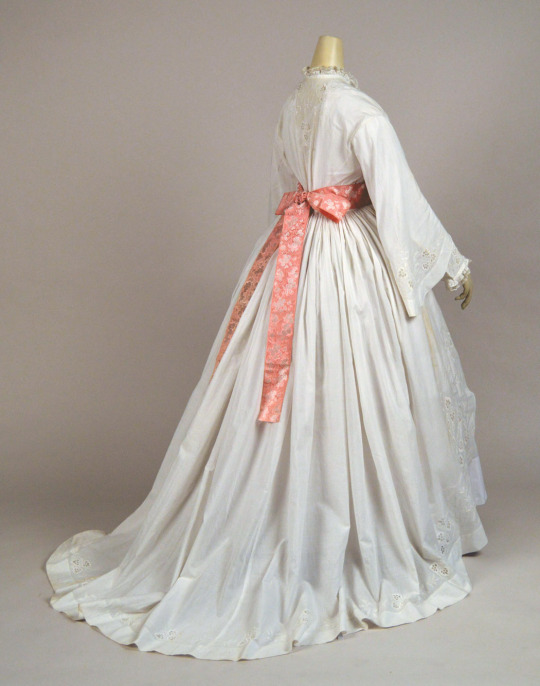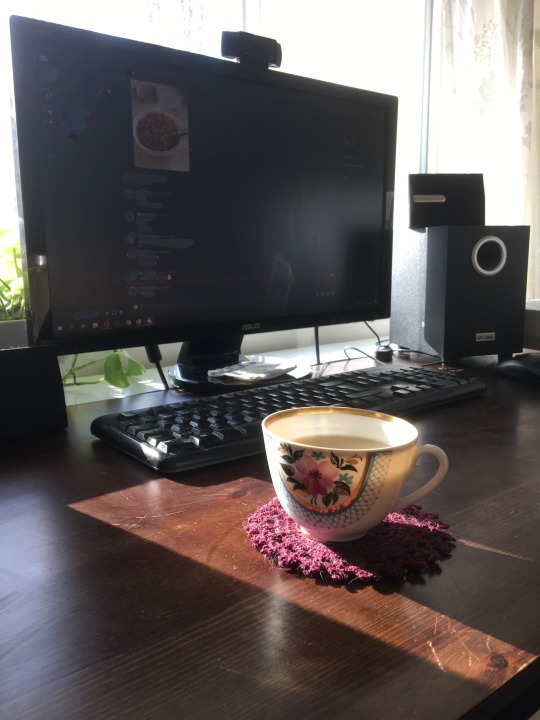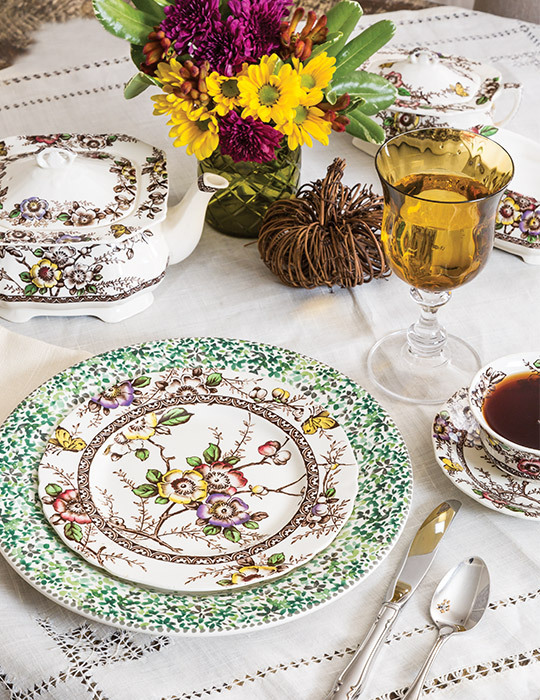#drawnwork
Explore tagged Tumblr posts
Text


Night Garden by UnaBuenaPieza
Propaganda: None Submitted (but you can leave some in the notes!)
Booklet of embroidery and drawnwork, probably Portuguese, early 17th century
Propaganda: this was the pattern of the year in 1624 and I believe it is the pattern of the year in 2024 too
25 notes
·
View notes
Text
Embroidered cotton morning robe
English or American, ca. 1860-65

Morning robe or peignoir of cotton with whitework embroidery, pagoda oversleeves and tight undersleeves with lace-trimmed ruffles at the wrists, lace-trimmed collar, and a lightly trained full skirt with curved edges at center front and fine cartridge pleating across back waistband. The stylized trailing floral and foliate embroidered motifs, worked primarily in satin stitch, knots, and drawnwork, are graduated in size and density down the center front from neck to hem and around lower edges of over- and undersleeves, and forming triangular shape on back bodice.
Cora Ginsburg
258 notes
·
View notes
Photo


My Gamer Aesthetic
I really can’t see myself ever getting sparkly LEDs or pleather accessories etc for my gaming or work spaces.
The speakers are a bit end-of-their-life, maybe. They’re from 2002. A cat terrorist destroyed their little legs, which I superglued back into shape again and again, until they just now can’t stay up anymore, because they’ve been shattered into too many pieces. I hate throwing away things that still technically work, but these 20-year-old little fellas have also lost their ability to make sounds with reasonable reliability. I’m getting recycled speakers this weekend though, and these old ones are headed for Finnish Electricity and Electronics recycling cycle next week (if you’re in Finland, check out SER-kierrätys.) Electronics contain a lot of precious metals that are dug up from earth, and our planet has finite resources, so it’s important to get all the materials back into production cycles. Here’s a quote from Finnish recycling website (on the Finnish version of this page they say they can recycle up to 99 % of the parts of electric and electronic waste.)
What happens to the collected devices?
It is important to deliver the waste electrical and electronic equipment to recycling, so that they do not end up burdening the environment!
The collected devices are primarily processed in Finland. In recycling, raw materials and other materials are released from old appliances to be used in industry. These materials are used in the manufacture of new products.
Dangerous and harmful materials are also collected from old appliances to be processed separately. This way, the harmful agents do not end up to the environment. Some of the undamaged devices returned to the recycling find their way to reuse after inspection.
The tea cup and the little table with the controllers are from a second hand shop as well, as is the little table cloth on it. I rarely need to buy anything new these days, Helsinki area second hand stores and reuse centres are piled high with perfectly good household items (and indeed I’m going on a crusade to find a new controller for my PS3. The old controller was destroyed by a cat.)
The small table cloth is fairly new, I got it on an unexpected adventure to Hyvinkää where I went on a fun day trip (go see the town museum if you can, there’s a really fun art exhibition there right now!) My inner textile nerd can tell with some authority that the style of decoration on the cloth is an old fashioned technique called “bottom sewing” in Finnish (can’t really say what it would be in English) and it’s usually combined with drawnwork embroidery. It was made popular by the fact that it didn’t require other materials besides the fabric it was made on, so it was cheap. These are quite rare to see nowadays, probably because the work is difficult-ish (I tried some myself with a 1950s guide book), but the payoff isn’t as fabulous or effective as even the plainest cross stitch embroidery, or bobbin lace. My strange little example is more beautiful still because the cloth has been woven with two different colours of flax, which gives a nuanced impression of colouring for the rows of the little holes.
So this has been your random bit of news about antiquated arts and crafts!
4 notes
·
View notes
Photo

8 notes
·
View notes
Photo

Spanish sampler (19th century).
Drawnwork, embroidery, cotton and metal thread.
Image and text information courtesy The Met.
100 notes
·
View notes
Photo

In the 1930s, this is what your favorite kitchen linen looked like! It’s a conglomeration of all the most exquisite needlework techniques... hemstitching, fabric appliqué and tone on tone embroidery. 🧵 Pure perfection of the prettiest kind! Find this one newly listed in the shop! . . . . . . #vintagelinens #hemstitch #vintageembroidery #drawnwork #needlework #vintagesewing #applique #yellowflower #kitchenlinen https://www.instagram.com/p/CGk5Gu5AWdw/?igshid=n3hvc16snlx4
#vintagelinens#hemstitch#vintageembroidery#drawnwork#needlework#vintagesewing#applique#yellowflower#kitchenlinen
2 notes
·
View notes
Photo
Gorgeous





Embroidered and Drawnwork Lace Veil, ca. mid 19th century
via Augusta Auctions
#embroidered lace#drawnwork#drawn work#lace veil#mid 19th century#victorian era#victorian fashion#antique veil#toile#19th century fashion
43K notes
·
View notes
Photo

#creature #rsgrafiko #sketchbook #drawnwork #penartwork https://www.instagram.com/p/B1t2VvqBN7U/?igshid=dljhmfdf4hkz
0 notes
Text


Gardener's Tribute by Virginia Soskin for 'Simply Cross Stitch 17', May/Jun 1994
Propaganda: A beautiful sampler-- especially the border! A timeless style that would not look out of place hanging in a home today
Booklet of embroidery and drawnwork, probably Portuguese, early 17th century
Propaganda: this was the pattern of the year in 1624 and I believe it is the pattern of the year in 2024 too
19 notes
·
View notes
Photo

Cushion cover, 18th century, Minneapolis Institute of Art: Art of Africa and the Americas
Cushion cover, square, embroidered mostly in red and blue on natural colored linen; strip of drawnwork outlined in blue across one side Size: 15 1/4 x 13 1/2 in. (38.7 x 34.3 cm) Medium: Embroidery on linen
https://collections.artsmia.org/art/14220/
7 notes
·
View notes
Photo

Bed curtain border, 1800–1850, Metropolitan Museum of Art: European Sculpture and Decorative Arts
Brooklyn Museum Costume Collection at The Metropolitan Museum of Art, Gift of the Brooklyn Museum, 2009; Ella C. Woodward Memorial Fund, 1931 Medium: Drawnwork, embroidery, bobbin lace, linen
https://www.metmuseum.org/art/collection/search/173364
6 notes
·
View notes
Photo

Italian sampler (18th century).
Drawnwork, whitework embroidery on linen.
Image and text information courtesy The Met.
32 notes
·
View notes
Photo

for sale #boutiqueetsy : Long antique French hand embroidered bolster cover case 4 bolster pillow w handmade drawnwork w embroidery, vintage French white bed linens #blanc #fleuri #lin #bedroom #bolstercushion #bolstercover #heirloomlinens #bolsterpillow https://etsy.me/3GFtb7p https://www.instagram.com/p/ClV5_gjI1Su/?igshid=NGJjMDIxMWI=
0 notes
Text
From Spiny Leaf to Gossamer Beauty
Author: Mary Lou Murillo
In celebration of the second annual New York Textile Month, members of the Textile Society of America will author Object of the Day for the month of September. A non-profit professional organization of scholars, educators, and artists in the field of textiles, TSA provides an international forum for the exchange and dissemination of information about textiles worldwide.
One of the finest textile traditions to come out of the Philippines, refined by weavers there for generations, the production of piña cloth endures today as a testament to the creativity and virtuosic skill of the artisans in the archipelago.
The pineapple (Ananas comostas), indigenous to Mexico and Brazil, was brought to the Philippines in the 16th century by Spanish conquerors and began to thrive in the lush hills and valleys of Aklan Province on Panay, one of the smaller central islands that make up the Visayas. The environment there was conducive to the growth of the leafy pineapple plant, a member of the Bromeliaceae family, and named piña (cone shaped) by the Spanish. Pineapple became an important agricultural product and the cloth produced from it eventually became a recognizable symbol, as one of the “national fabrics” of the Philippines. [1] The method of producing piña cloth is labor intensive, beginning with the harvesting and preparation of the material used to make piña threads. The threads used for weaving are comprised of the fine, white inner fibers of the pineapple plant leaves. The leaves are pulled from the plant after about 18 months, when the average length of a leaf is around 24 inches. After scraping away the coarse outer fibers from the upper part of the leaf with a broken dish or coconut shell, the fine inner fibers, called linawan, are collected and then beaten, washed and dried. The strands are meticulously knotted together one by one in order to create long continuous lengths of single-ply untwisted thread suitable for weaving. [2] The knotted yarns are wound onto skeins and then sold as piña thread to be woven traditionally on a treadle loom, historically by a select group of women.
From the raw material of a spiny leaf, the most beautiful fabrics can be produced; the look of a piña cloth fabric is sheer, and crisp yet with a diaphanous quality. The woven fabrics are often embellished with embroidery in cotton and silk threads, as well as with dyeing and supplementary weft decoration. Due to the extremely fine and fragile fibers, the textiles most commonly made of piña fabric include flat and un-seamed textiles such as collar-shawls, or pañuelos, kerchiefs, handkerchiefs and garments like women’s blouses and the outer shirt for men, including the iconic barong tagalog. [3]
This long embroidered scarf, or kerchief, is dated circa 1770 by an archival letter accompanying the accession. The letter details the gifting of the textile to a noblewoman in that year. It was hand-woven in plain weave and decorated with cotton and silk blend embroidery. The embroidery and drawnwork, or calado, about the scalloped border depict flower and foliate motifs, and two large motifs of flowers emanating from a vase appear at each end. A fine piece such as this may have been worn by the elite woman, like a veil, draped or folded over the head and adorned with a gold comb, or carried over the shoulders or arms like shawls in European fashion. [4]
Portrait of a Spanish mestiza of Manila, dressed for church with a veil over her head. Nineteenth century (Artist unknown), from “Pina” by Lourdes R. Montinola, p.73.
[1-2] Davis, Marian L., “Pina Fabric of the Philippines”. In Arts of Asia. Wanchai, Hong Kong: Arts of Asia Publications Limited, July-August 1991, p. 126 [3-5] Montinola, Lourdes R., Piña. (Manila: Amon Foundation, 1991), p. 69, pp. 83-84
Mary Lou Murillo is Museum Specialist for Textiles at the American Museum of Natural History.
from Cooper Hewitt, Smithsonian Design Museum https://ift.tt/2MLP7OH via IFTTT
9 notes
·
View notes
Text



Booklet of embroidery & drawnwork - early 17th century. Probably Portuguese.
1 note
·
View note
Text
A classic, vintage pattern has been knocked out by-- well, I guess as classic and vintage a pattern as you can get!
Congrats to the booklet of embroidery and drawnwork as it advances to round two, and 'best of luck' to the sampler! Perhaps December simply isn't the season for gardening.


Gardener's Tribute by Virginia Soskin for 'Simply Cross Stitch 17', May/Jun 1994
Propaganda: A beautiful sampler-- especially the border! A timeless style that would not look out of place hanging in a home today
Booklet of embroidery and drawnwork, probably Portuguese, early 17th century
Propaganda: this was the pattern of the year in 1624 and I believe it is the pattern of the year in 2024 too
19 notes
·
View notes